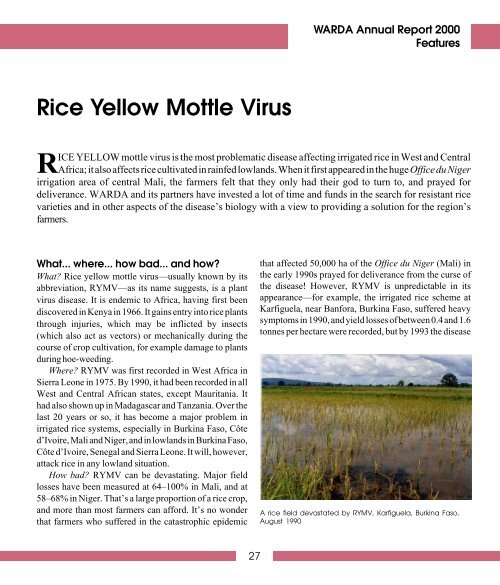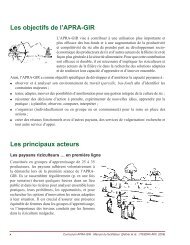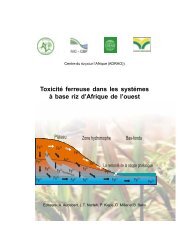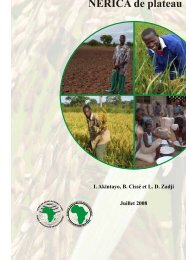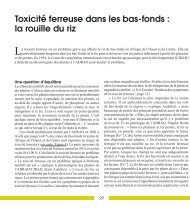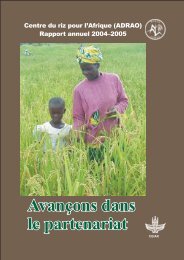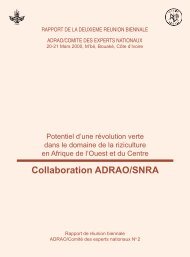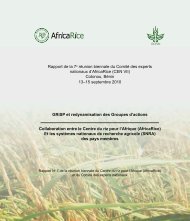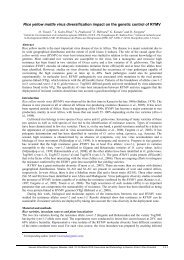Rice Yellow Mottle Virus - cgiar
Rice Yellow Mottle Virus - cgiar
Rice Yellow Mottle Virus - cgiar
- No tags were found...
You also want an ePaper? Increase the reach of your titles
YUMPU automatically turns print PDFs into web optimized ePapers that Google loves.
WARDA Annual Report 2000Featureswas restricted to a few small patches in a few farmers’fields. WARDA’s Plant Pathologist Yacouba Séré isunder no delusion about the threat that RYMV poses:“RYMV has the potential to devastate lowland riceanywhere in Africa,” he says. “And crop losses seem tobe higher in the large monocrop irrigation schemes in theSahel than in the smaller schemes in the humid zone.” Ifwe take that as our baseline, then there is in excess of 3million ha of lowland and irrigated rice potentially at riskfrom RYMV in Sub-Saharan Africa.How? There are two aspects to the “how” question.First, how does the disease ‘get a hold,’ or what puts a ricefield at risk from RYMV attack? Second, how does thedisease affect the plant and cause yield loss? We get theclue as to how the disease was encouraged by looking atthe catastrophic epidemic of the Office du Niger. Séréagain: “RYMV came almost as an immediate ‘result’ ofchanges in management of the irrigated rice crop. Inparticular, the change from direct seeding to transplanting.”The act of uprooting the rice seedlings and transplantingthem inevitably inflicts some damage on the roots.If there is any RYMV in the field into which the rice istransplanted, the virus can enter the plants via the injuredroots. Séré continues: “But then the disease was able tospread rapidly because 70 to 90% of the area in eachcountry was planted with the same high-yielding varieties—varietiesthat are unfortunately susceptible toRYMV.” So, when RYMV was not a problem, the factthat the popular varieties were susceptible to it was of noconsequence. However, as soon as transplanting wasintroduced, giving RYMV a foot-hold, the susceptibility ofthe varieties was the farmers’ undoing!“There are four principal characteristics of RYMVsymptoms on a rice plant,” explains Séré, “and these givean indication of how yield-loss is effected: chlorosis of theleaves, stunting, reduced panicle exsertion, and paniclesterility.” Chlorosis in plants is a reduction in greenpigment. Since the green pigment in plant leaves is the allimportantenergy-capturing chlorophyll, chlorosis resultsin reduced photosynthesis, and therefore reduced plantgrowth. Stunting refers to severely reduced plant height—infected rice plants are simply much shorter than healthyHealthy (background) andRYMV-infected (foreground)rice. Note the paleness of theleaves (chlorosis) and shortstature of the plants (stunting)There’s no food inside sterilegrains!The panicles of infected plants (left) do notexsert properly28
WARDA Annual Report 2000Featuresones. Panicles are the grain-bearing parts of the plant andtherefore essential to good yield. In RYMV-infestedplants, the panicles often do not grow normally. What ismore, many of the grains on an infested panicle aresterile—that is, either the grains are not formed or elsethey are empty.With such potential to wreak havoc in lowland ricefields, and such unpredictability, RYMV was an obvioustarget for WARDA research. With WARDA taking thelead, the research takes on a regional perspective, and theindividually affected countries are not working in isolation.Groundwork and developing a researchstrategy for RYMVWARDA’s first experiences with RYMV were notalone. “Before WARDA joined the Consultative Groupon International Agricultural Research (CGIAR) in 1987,”explains WARDA Deputy Director for Research MontyJones, “the International Institute of Tropical Agriculture(IITA) in Ibadan, Nigeria, also had a mandate for rice inWest Africa.” Thus, region-wide surveys for RYMV in1984 were conducted jointly by WARDA and IITA. Itwas these surveys that detected the disease in the majorityof West African countries. However, it was a few moreyears before RYMV came to the fore of the WARDAresearch agenda.In the early 1990s, Yacouba Séré was working for hisnational program in Burkina Faso, but was also a memberof the newly formed Integrated Pest Management (IPM)Task Force of WARDA. “In February 1992, we had ourfirst meeting,” he explains, “at which we identified regionalpriorities for disease, pest and weed research.RYMV and blast were identified as top priorities.”In September 1995, several donors sponsored a regionalsymposium on the disease to review the state of theart, and determine research priorities. Among others,representatives from the Malian and Nigerien nationalprograms, together with representatives from the Officedu Niger irrigation scheme, made it clear that RYMVwas their Number One rice research priority. The findingsof the symposium were taken by WARDA and its IPMTask Force to develop the first RYMV research strategyfor the region. “A project proposal based on this strategywas developed and then accepted by the UK Departmentfor International Development (DFID),” explains Séré,“and much of the on-going work has been funded by DFIDever since.” The research strategy that was developed inthe mid-1990s remains relevant even today:■ <strong>Rice</strong> varieties resistant or tolerant to RYMV needto be identified to replace susceptible varietiesgrown by the majority of farmers■ Resistant rices need to be identified, even if notsuitable for release to farmers, for use in thebreeding program for RYMV resistance, and theirresistance needs to be characterized; then, newresistant varieties can be bred from this material■ Strategic research concentrates on filling in thegaps in existing knowledge of the disease, especiallyin disease epidemiology, with a view to developingintegrated management of RYMV in thelowlands of West Africa.The importance of screeningThe three countries that are the focus of the DFID-fundedscreening project share a common problem: most of theirirrigated-rice farmers grow varieties that have provenhighly susceptible to the onslaught of the spreading RYMVepidemic—Bouaké 189 in Côte d’Ivoire, BG90-2 in Mali,and IR 1529-680-3 in Niger.Screening for resistance to RYMV was actually startedin the mid-1980s by IITA. Owing to the ferocity of thevirus epidemics, and the urgent need to find resistantmaterial, large nurseries were established and distributedthrough the International Network for Genetic Evaluationof <strong>Rice</strong> in Africa (INGER-Africa)—formerly operatedthrough IITA by the International <strong>Rice</strong> Research Institute(IRRI), but relocated to and operated by WARDA in1997.29
WARDA Annual Report 2000FeaturesDiagnosing the diseaseSymptoms are not always indicative of RYMV, soresearchers require a simple test to determine whetherthe virus is present in plant tissues.The fact that virus particles elicit an immune responsefrom animals and plants is used by plant pathologists toaid the identification of virus diseases. Antibodies can beproduced by inoculation of the virus into a suitable host(often rabbit). These antibodies can be isolated, purified,concentrated and then used as a sensitive test for thevirus in plant tissue. ‘Polyclonal’ antibodies to RYMVhave been developed at the WARDA pathologylaboratory. These antibodies attach themselves to thevirus’s protein coat, they are easy to produce, and arenot strongly pathotype-specific. These antibodies havebeen made available to WARDA’s partners in thosecountries that need a rapid tool for diagnosing RYMV.Inauguration of the screen house constructed in Mali underthe DFID-funded screening projectIn order to ensure high disease pressure without therisk of starting an epidemic, screening for disease resistanceis done in isolation, in what is known as a screenhouse. By this method, the test plants are not left to thevagaries of natural disease spread, which vary in spaceand time, but are artificially subjected to high diseasepressure. At the same time, the virus is confined within thescreen house and prevented from starting a diseaseoutbreak in rice fields in the vicinity. The screen housesare also used for the uninoculated, or control, plants, tokeep them free from possible outside infection.At first, screen houses were only available atWARDA, and ‘hot-spot’ screening by the national programsdepended on natural disease spread. However,the DFID project established screening facilities in Maliand Niger. These will improve the screening efficiency,especially as more and more breeding material needs tobe tested.Pathotypes: variations on a theme“We did the initial screening against RYMV in the screenhouse at WARDA’s Main Research Center at M’bé,”continues Séré. “We used an isolate of the virus fromGagnoa [south-central Côte d’Ivoire] and identified agood number of resistant and tolerant lines.” The troublewas that when these lines were taken to other sites inCôte d’Ivoire for field testing, many of them were nolonger tolerant! “This is why RYMV is the most problematicdisease of irrigated rice in West Africa,” says Séré.“The virus is highly variable—the viruses in one locationare not necessarily the same as those in anotherlocation.” The different types of RYMV are known aspathotypes. This makes the whole issue of rice resistanceto RYMV rather complicated, since a variety that isresistant in one location to one pathotype may be susceptiblein another location where there is a different pathotype.A highly virulent pathotype is defined as one thatattacks many of the differential varieties. Conversely, apathotype with low virulence attacks only a few varieties(see Table 1). The virus isolate from Gagnoa, used in theearly screening trials, had low virulence, and so theselected lines were attacked by the more virulent pathotypesof RYMV in the field at sites like Danané andOdienné.30
WARDA Annual Report 2000FeaturesTable 1. Virulence of two RYMV pathotypes on the differential set of varieties.DifferentialReaction with pathotype†Hypervirulent(from Odienné)Hypovirulent(from Korhogo)Gigante (Tete) – –Bouaké 189 + +Faro 11 + –Morobérékan + –Lac 23 + –ITA 305 + –PNA 647 F4-56 + –H 232-44-1-1 + –† + = symptoms, – = no symptoms.Another source of pathotype variationA rice variety that is grown at a site where it is resistant tothe local pathotype may ‘lose’ its resistance if a newpathotype spreads into the area. But this may not be theonly source of variation. Pathologist Yacouba Séréexplains: “RYMV has its genetic code on a single strandof RNA, therefore any mutation is likely to be expressedin the virus makeup.” Most organisms have two strandsof DNA, so that mutation in one is likely to be masked (thatis, prevented from being expressed) by the dominantgene for the same character on the other member of thepair. “Therefore,” continues Séré, “there is potential forpathotypes to change by mutation.” This has not yetbeen proved in the field, but WARDA has started to studythe stability of the virus population structure at certainsites.“With individual variation among pathotypes andvarieties,” explains Séré, “we end up with a matrix, or grid,of pathotype versus variety in terms of which pathotypesattack which varieties or, conversely, which varieties aresusceptible to which pathotypes.” Thus, a set of varietiesmay be used to differentiate a range of pathotypes—thisis then known as a set of ‘differential varieties.’“At present we have a differential set of eightvarieties for RYMV pathotype characterization in Westand Central Africa,” says Séré, “but this is being refinedin collaboration with our NARS partners.” ‘New’ virusisolates are collected in each country and then tested (inthe same country) on a set of 15 to 20 varieties—the eightdifferentials are used in all the sets as a cross-referencepoint. “In Côte d’Ivoire,” Séré continues, “we currentlyidentify six pathotypes on the eight differential ricevarieties.”Differences among virus pathotypes must bedetectable at the molecular level. Our partners at theInstitut de recherche pour le développement (IRD,France) and the International Laboratory for TropicalAgricultural Biotechnology (ILTAB, USA) have beenworking on sequencing of the genetic code of severalRYMV isolates. This is with a view to developingpathotype-specific tests for use in outbreak areas.First fruits of the search for resistanceFifteen, or so, years of screening have not been withoutsome success: resistant or tolerant material (see Box‘Resistance vs tolerance,’ page 33) has been identified inthe three main rice types.31
WARDA Annual Report 2000FeaturesResistance v toleranceA crop variety is resistant to a disease if that disease has a less damaging effect on the resistant variety than it does on other(susceptible) varieties. The resistance may be the result of the disease being less able to infect the plant (i.e. enter its tissues),multiply or move within a plant of the variety, or it may be due to the variety’s ability to grow and yield better than susceptiblevarieties despite being infected. The latter form of resistance is known as ‘tolerance’ (see Table 2).Table 2. Effects of disease pressure on yields (g/m 2 ) of rice varieties susceptible, tolerant and highly tolerant to RYMV. Notehow the tolerant varieties out-yield the susceptible one at high disease pressure; the highly tolerant variety also out-yieldsthe susceptible one at low disease pressure.Variety Reaction to Disease (RYMV) pressureRYMVNone Low HighBouaké 189 Susceptible 590 164 38WITA 11 Tolerant 294 168 107IR 47686 Highly tolerant 274 268 136The trouble with toleranceThe problem with ‘field’ screening is that symptoms do not tell the whole story. As an additional level of assessment, plantsclassified as resistant or tolerant on symptoms were subjected to laboratory-based pathological tests, to look for the presenceof virus particles within the plants. “Once we were in the laboratory,” explains Pathologist Yacouba Séré, “we found thatnot all the resistant material was the same. Some of the lines that had no or few symptoms in the screen house had very littlevirus inside them and could rightly be classified as resistant. However, other lines that looked just the same as the resistantones in the screen house were in fact full of virus particles. What is more, if we let the plants grow to maturity in the screenhouse, we discovered that those in the latter group in fact gave reduced yield.” These plants can fairly be termed tolerant,but Séré sees little future for this group: “the plants in these groups may be tolerant, but they provide a source of virus inoculumready to infect adjacent plants or neighboring fields. Since one of our goals is to reduce disease pressure in the field, I donot want such plants around, and neither should a conscientious farmer!”In last year’s Report, we mentioned that our partnersat the IRD had identified a gene that confers RYMVresistance in both Oryza glaberrima and O. sativa, andmolecular markers associated with it (see ‘MolecularBiology Facilities at WARDA,’ WARDA Annual Report1999, especially page 20). WARDA Molecular BiologistMarie-Noëlle Ndjiondjop takes up the story: “with adesirable gene and appropriate markers to follow itsinheritance by the offspring of a cross, we have the meansto conduct marker-assisted selection for RYMV resistance.”The great advantages of marker-assisted breedingare, first, that the material does not have to be screenedin the field or in the screen house in the early generationsand, second, that the markers can be detected in youngplants, so time and space is not taken up with growing largenumbers of plants every season—only those with therequired gene need be grown to maturity for their seed.“When we combine this with other tools, such as doublehaploidbreeding,” continues Ndjiondjop, “we can speedup the production of useful lines considerably.”33
WARDA Annual Report 2000FeaturesBut the breeding does not stop there. “A variety witha single gene for resistance is still very vulnerable,”explains Miézan. “If the local virus pathotype shouldmutate, or another pathotype arrive in the area, thevariety’s resistance could very well break down. In theworst scenarios, the disease resistance of upcomingvarieties has been known to break down even before thevariety is released. Then we are back to square one andyears of work are effectively wasted!” This is whyWARDA talks about ‘durable’ resistance—the aim of thebreeding program is to combine several genes for resistanceinto varieties, so that they are fore-armed againstmutations and invasions of new pathotypes. Ndjiondjopagain: “once we know the type of resistance operating ina particular variety or line, and the genetics of its inheritance,then the same tools that make it possible to transferone gene can be used to speed the process for combiningresistance genes.”Meanwhile, the John Innes Centre in the UK hasdeveloped transgenic resistance from the coat protein ofthe RYMV particle itself. This transgene has been successfullyincorporated into popular varieties Bouaké 189and BG90-2, which will be available for testing in theregion once biosafety regulations are in place (see Box‘Transgenics and biosafety’).Epidemiology—the how and why ofdisease epidemics“We do not want to be limited to using just resistantplants,” says Séré. “After all, we’ve been screening forover 15 years, and there are still no highly resistantvarieties in farmers’ fields!”“One thing that became perfectly clear at the 1995symposium,” he continues, “was that we knew so verylittle about the epidemiology of the disease, and there wereso many questions to be answered.” Thus, elucidating thecomponents of RYMV epidemiology was, and continuesto be, one of the principal foci of the WARDA researchon RYMV.Transgenics and biosafetyThe transgenic rices developed by the John InnesCentre in the UK are ‘genetically modified organisms’(GMOs). As such they need special treatment. “Thereare genuine concerns around the world about thepotential effects of GMOs on the ‘natural’ environment,”explains Pathologist Yacouba Séré. The UK-based GatsbyFoundation not only funded the original research onRYMV at John Innes Centre, but have also beensupporting WARDA’s efforts to ensure proper handlingand regulation of the plants should they come to WestAfrica.“Gatsby are funding the construction of acontainment facility at our M’bé site,” continues Séré.The idea of this construction is to enable the testing of thenew material in an appropriate climate and with thelocal pathogens with minimal risk of their escape. Thecontainment facility will effectively isolate the transgenicmaterial from the surrounding vegetation. Not only is itlocated at some distance from the nearest experimentalfields, but it is in itself a barrier to pollen flow—it is the fearof pollen flow from transgenics to cultivated and wildspecies, and the consequent ‘escape’ of the transgenesthat environmental groups are so worried about. “Thus,we will be able to test the material to ensure that it isstable against the virus pathotypes here, and also hasno undesirable effects once exposed to the prevailingclimate, while safeguarding the surrounding environmentfrom possible contamination,” says Séré.“In addition,” he continues, “we have been workingwith our member states on the whole issue of biosafety.”First, the state governments need to know what the GMOissue is all about, and then they need appropriateregulations. “And it is no good having a biosafetyregulation in only one or a few countries,” says Séré.“Farmers can cross international borders as easily asanyone else, and cross-border trade in seeds is a wellknownphenomenon in the region.” WARDA has beenactively involved in the development of biosafetylegislation in Côte d’Ivoire and this has regional implications:it could serve as a template for regional guidelines,as well as being promoted among other member states’policy-makers as the basis for national legislation regionwide.“Without blanket application of biosafetyregulations for the exploitation, diffusion and marketingof transgenic crop plants, we will not consider introducingsuch plants into individual countries of the region,” explainsDirector General Kanayo F. Nwanze.34
WARDA Annual Report 2000FeaturesAn important early finding was that RYMV is ‘inoculumdependent.’ That is, the more virus there is in theenvironment, the worse the disease affects the crop.Thus, if we have a field of a susceptible variety, the worsethe disease pressure, the more virus (inoculum) is produced—avicious spiral.“What we want, therefore,” says Séré, “are options forreducing disease pressure in the field. Planting resistantvarieties is just one of these options.”A first question that anyone interested in crop pestcontrol is likely to ask is: “where does the organism spendthe off-season?” In the case of RYMV, rice is notcultivated in the fields continuously for 12 months eachyear, so the virus has to live somewhere else when there’sno rice in the fields. Three groups of alternative hosts havebeen identified for RYMV: crop residues, volunteer riceplants, and weeds. Crop residues are the bits left afterharvest of the grain, they include roots, stems and straw.RYMV can survive on any or all of these—simpledestruction of crop residues after harvest should, however,remove this option. Volunteers are rice plants thatgrow up during the off-season from grain scattered orspilled at harvest time. These are a little more problematicthan residues, in that they have to be dealt with some timeafter the harvest of the crop, which puts an extra demandon the farmers’ time. However, removal of volunteerscould be combined with a post-harvest weeding, thatwould also deal with the third reservoir of off-season virusinoculum.Once we know where the virus spends the off-season,the next question is: how is it transmitted? “The essentialaspect of the epidemiology of RYMV,” explains Séré, “isthe role of mechanical injury of plants—any mechanicalinjury in the presence of virus particles.” In addition to rootdamage during transplanting, rice plants are especiallyprone to damage during weeding operations when farmersuse hoes—if an infected rice plant is damaged duringweeding, virus is deposited on the hoe. If a healthy plantis then damaged with the same hoe, the virus is immediatelyavailable to enter via the fresh wound. The virus can‘Inoculum dependence’: gradation of RYMV symptoms fromuninoculated (left) through spot-inoculated and single-leafinoculated, to fully inoculated plants of Bouaké 189also survive in irrigation water, so any damage inflicted ona plant in a flooded field is prone to virus infection fromcontact with contaminated water. Then, of course, thereis the whole issue of insect vectors.WARDA Entomologist Francis Nwilene takes up thestory: “It has been known since 1974 that insect vectorstransmit RYMV mechanically. That is, they feed on aninfected plant, collect virus particles, and then pass themon to the next plant that they feed on—the virus does notundergo any changes within the insect itself, but simplyuses it as a vehicle.” Some 12 insect species are knownto transmit RYMV between rice plants, and from riceplants to alternative (weed) hosts, including beetles andgrasshoppers that bite the plants, and leaf-sucking bugs.Another avenue for controlling the disease is therefore tocontrol the vectors—this has been a focus of WARDA’sentomology work in 2000 (see Box ‘Controlling the vectorsof disease’).Integrated management of RYMV and thefutureLike so many problems that affect growing crops, there isno single method of approaching RYMV that is going torid the region’s rice of this insidious disease. Instead, we35
WARDA Annual Report 2000FeaturesControlling the vectors of diseaseWith the exception of insect vectors, all the mechanismsfor virus infection require the presence of the virus eitherin the field to which rice is transplanted, or else in thenursery. Entomologist Francis Nwilene: “if a field iscompletely cleared of virus during the off-season—forexample, by destruction of all crop debris, ratoons,volunteers and alternative hosts—then the only sourceof RYMV lie outside the field, and it is only the insects thatcan bring it to the crop. Thus, there is justification forlooking at methods for controlling these insects.”Like the disease itself, there is no single control measurethat does a satisfactory job. “We have left the route ofhost-plant resistance to the breeders and pathologist,”explains Nwilene, “and have concentrated on culturalmethods and bio-pesticides.” The logic behind the plantresistancedecision lie in the extensive screening that hasbeen done, which will select for insect-resistant types asmuch as for purely virus-resistant types.Among the cultural practices, water managementcan play a key role in the dry (off-) season. “During thedry season,” explains Nwilene, “the vectors tend to leavethe uplands, as the air is too dry for them, and their foodsupplies are dying out.” If the lowlands are also drainedat that time, the humidity there will also be reduced, andthe food supply there will also be diminished, withconsequent impact on the vector population in thelead-up to the cropping season.“One positive trend,” Nwilene continues, “is the movetowards direct seeding.” This trend is driven by laborcosts, but it has two advantages in the fight againstRYMV. First, there is no transplantation-induced rootdamage. Second, the populations of vectors spends thewhole season in an interactive phase with its naturalenemies (predators, parasites)—there is no relocation ofvectors with seedlings, and a certain level of naturalcontrol is achieved.However, it is the potential role of bio-pesticides thatattracted Nwilene’s attention in the last season. “Wecompared the effects of extracts from neem andpawpaw with commercial insecticide Decis,” he explains.“I’m delighted to report that neem oil was not only moreeffective in controlling all three groups of vectors [beetles,grasshoppers and leaf-sucking bugs] than pawpawextract was, but also even better than Decis! What ismore, the preliminary results suggest that the neem oilhad less of an impact on the vectors’ natural enemiesthan either of the other two insecticides.” Research intothis potential role for neem oils is continuing in the 2001 wetseason.need to combine elements to provide adequate relief. Asis often the case when dealing with resource-poor farmers,the researchers’ first line of approach is through thedevelopment of resistant varieties—WARDA and itspartners have come a long way with this work, but thereis still much to do, as explained above. This, however, isbacked up with other interventions—using appropriatecultural practices to minimize the spread of the disease,removing alternative hosts where virus populations cansurvive or build up over the off-season, and managinginsect vectors. “In 2001,” explains Séré, “we will begin tolook at the role of overall crop management, includingfertilizer, in the epidemiology of the disease, and that mayprovide yet another entry into RYMV population control.”Also in 2001, WARDA is expecting to begin collaborationwith the University of Leuven, Belgium on a projectto enhance the sustainability of rice production in RYMVhot-spot locations. This will involve training of nationalprogramadvisers and farmers on virus management. Inaddition, the project aims to develop new tools for identifyingthe virus—within rice plants and insect vectors, andin the field—and others for monitoring the disease in thefield (in relation to climate).Another approach in the RYMV work is throughWARDA’s Interspecific Hybridization Project. Specificareas of interest are identification of the types of resistancepresent in the three basic rice groups—Oryzaglaberrima, O. sativa subspecies indica, and O. sativasubspecies japonica; continued study of RYMV variabilityin West, Central and East Africa; and, further strengtheningof the collaboration with national programs onscreening of new material. This latter element will involvethe production of further targeted crosses between popularlocal O. sativa varieties and O. glaberrima, which willbe screened and further advanced at WARDA. However,it will not be the final products of breeding that aresent to national programs from screening against the mostvirulent local isolates in screen houses. This will enablenational breeders to select for adaptation to local conditionsin addition to RYMV resistance.36
WARDA Annual Report 2000FeaturesCapacity building for national partnersFrom the beginning, WARDA’s work on RYMV has been conducted through partnerships. The whole issue of multilocationscreening of varieties brings a need for partnership in itself. However, as the screening progressed, and especially with theadvent of the DFID in-situ screening project, it was necessary to upgrade the capacities of some of our partners—to trainthe national-program technicians to actually conduct the screening in the screen houses. In addition, the developmentof the polyclonal antibodies for detecting RYMV in plant tissue meant that we had to train laboratory technicians incollaborating countries in their use.By providing training to our partners, we are not only providing a service to the countries concerned, but rather to thewhole region. The information produced from the in-situ screening work feeds into the whole RYMV research process, whichwill ultimately benefit lowland-rice farmers in RYMV-endemic areas throughout Sub-Saharan Africa.Then again, we are not only interested in today’s research-workers. We are also providing input into the training oftomorrow’s pathologists. After all, rice systems and RYMV itself are biological entities—the virus will eventually adapt towhatever control measures we put in place, or else another disease could come along to fill the niche of RYMV should weever come close to eradicating it. Thus, we need an upcoming cadre of pathologists ready to tackle tomorrow’s plantdiseaseproblems. Linkages have been established with universities in Côte d’Ivoire and Mali for basic methodologies forscreening and scoring, plus research topics such as the variation in pathogenicity (virulence) of Ivorian isolates of RYMV.“We are at a very exciting stage with the RYMVwork,” says WARDA’s Director General Kanayo F.Nwanze. “We have nearly reached our short-term goal ofseeing improved virus-resistant rice in the fields of farmersin those areas where the disease is endemic, and wehave identified certain components to initiate integratedmanagement of the disease at farm level. The next fewyears will see an increase in the amount of resistantmaterial available, and some of this will not only havedurable resistance, but also be attractive to farmers inother ways, such as plant and grain types and cyclelength. We trust that never again will farmers be throwninto despair by the site of their fields devastated byRYMV.”37


